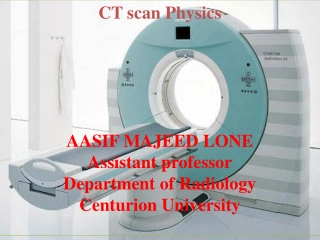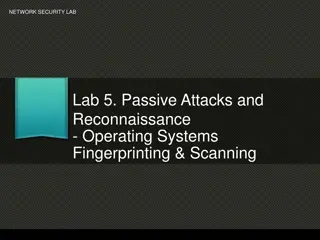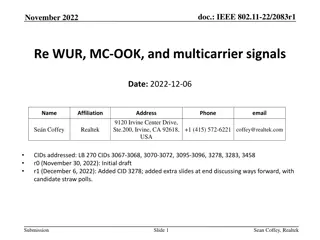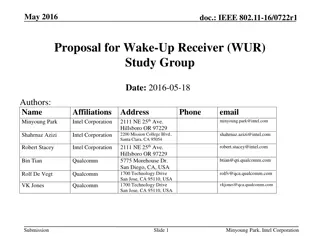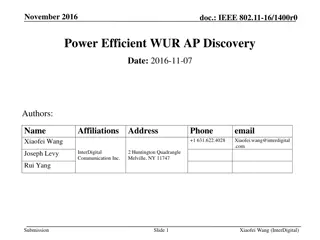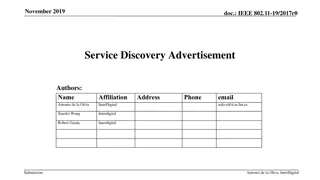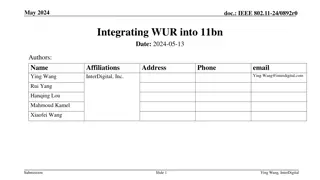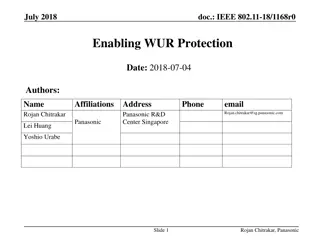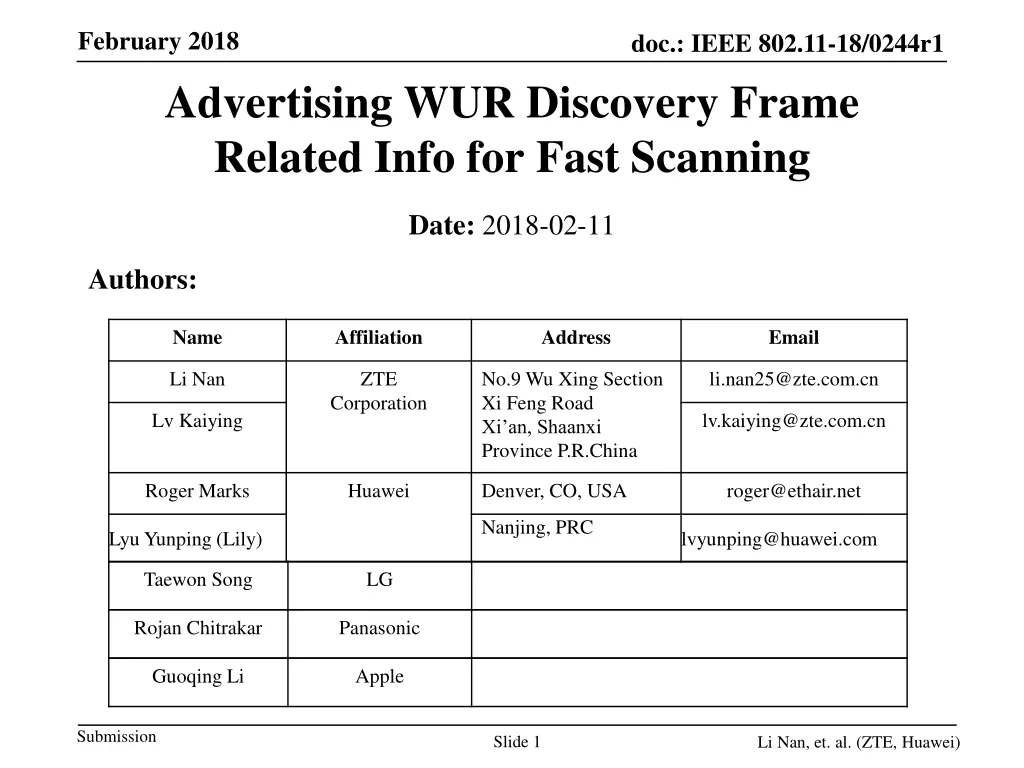
IEEE 802.11-18/0244r1 WUR Discovery Frame for Fast Scanning
This document proposes additional details for applying Usage Model 9 (Smart Scanning) of the WUR Usage Model to IEEE 802.11 TGba, focusing on the advertisement of WUR Discovery frame characteristics to enhance scanning efficiency and power saving in mobile devices. The utilization of the ultra-low power WUR receiver facilitates faster and more efficient scanning through multiple channels for nearby APs, reducing roaming latency and power consumption.
Download Presentation

Please find below an Image/Link to download the presentation.
The content on the website is provided AS IS for your information and personal use only. It may not be sold, licensed, or shared on other websites without obtaining consent from the author. If you encounter any issues during the download, it is possible that the publisher has removed the file from their server.
You are allowed to download the files provided on this website for personal or commercial use, subject to the condition that they are used lawfully. All files are the property of their respective owners.
The content on the website is provided AS IS for your information and personal use only. It may not be sold, licensed, or shared on other websites without obtaining consent from the author.
E N D
Presentation Transcript
February 2018 doc.: IEEE 802.11-18/0244r1 Advertising WUR Discovery Frame Related Info for Fast Scanning Date: 2018-02-11 Authors: Name Affiliation Address Email Li Nan ZTE No.9 Wu Xing Section Xi Feng Road Xi an, Shaanxi Province P.R.China li.nan25@zte.com.cn Corporation Lv Kaiying lv.kaiying@zte.com.cn Roger Marks Huawei Denver, CO, USA roger@ethair.net Nanjing, PRC Lyu Yunping (Lily) lvyunping@huawei.com Taewon Song LG Rojan Chitrakar Panasonic Guoqing Li Apple Submission Slide 1 Li Nan, et. al. (ZTE, Huawei)
February 2018 doc.: IEEE 802.11-18/0244r1 Abstract This contribution, intended for presentation to IEEE 802.11 TGba, proposes additional details to apply Usage Model 9 ( Smart Scanning ) of the WUR Usage Model Document (IEEE 802.11-17/0029r10), consistent with the Specification Framework for TGba (IEEE 802.11-17/0575r09). The key point is the advertisement of the WUR Discovery frame characteristics, including channel and information about discovered AP. Submission Li Nan, et. al. (ZTE, Huawei)
February 2018 doc.: IEEE 802.11-18/0244r1 Background Usage Model 9: Smart Scanning: Mobile devices passively scan through multiple channels using WUR, collecting basic information about nearby APs. The collected info can be used to facilitate roaming decisions and provide location information. Since WUR is an ultra-low power receiver, offloading some of the passive background scans to WUR can significantly save even more power. Submission Slide 3 Li Nan, et. al. (ZTE, Huawei)
February 2018 doc.: IEEE 802.11-18/0244r1 Usage Model 9: Smart Scanning Use case 2: Ultra low power roam scan Mobile devices sometime scan for roaming purposes. These roam scan sometimes is triggered when link quality degrades. These roam scan takes time because the scan is typically done on multiple channels, and on each channel the device either conducts active scan during which it sends a probe request and typically stays awake until it receives a probe response, or passive scan during which it dwells on each channel for at least a Beacon interval to receive a Beacon. As a consequence, scanning through multiple channels introduces roaming latency and consumes power. Sometimes, it runs into conflict with regular data exchange. Use case 1: Ultra-low power location scan Mobile devices sometimes scan through multiple channels for nearby APs, and use the measured Wi-Fi signal strength for improved location services. In addition, scanning on main radio has the risk of conflicting with regular data exchange. In WUR-facilitated location scan, the mobile device scans through the channels using the WUR receiver, and uses the signal strength measured from WUR packets received from adjacent APs to provide additional information to the location services on the mobile device. In other words, some of the location scan on main radio can be offloaded to WUR radio. In WUR-facilitated roam scan, the mobile device passively scans through multiple channels using WUR, and collects basic information about nearby APs. The collected info can be used to facilitate the devices roaming decisions. Because WUR consumes much less power than main radio, WUR facilitated location scan provides an ultra-low power location scan mechanism. Because WUR consumes much less power than main radio, WUR- facilitated roam scan provides an ultra-low power roam scan. In addition, due to the low power operation, WUR scan can be performed quite frequently in the background, and thus roaming information can be readily available whenever needed, i.e., it reduces roaming latency. Submission Li Nan, et. al. (ZTE, Huawei)
February 2018 doc.: IEEE 802.11-18/0244r1 Usage Model 9: Some Questions 1. What is the WUR discovery frame format that allows unassociated STAs to interpret the AP s identity ? see 802.11-18/0160r7 for details note: Spec Framework (802.11-17/0575r9) says 4.8 WUR Discovery Define a type of WUR frame as WUR Discovery frame to assist the STAs to discover the BSS. 2. How does the mobile know where to find desired WUR Discovery Frame in low latency? Submission Li Nan, et. al. (ZTE, Huawei)
February 2018 doc.: IEEE 802.11-18/0244r1 Proposed Method WUR STA uses its wake up radio to scan for and read WUR Discovery Frames. WUR Discovery Frame provides information about its own BSSs for the purpose of roaming or location services. To facilitate fast and efficient scanning, WUR STA can leverage the information previously received on PCR to learn which WUR channels to scan for WUR Discovery frame. WUR Discovery information of APs advertised on PCR should include: WUR Discovery Channel and compressed SSID. BSSID. Note: the computation of compressed SSID is TBD. The WUR Discovery channel should be selected from a fixed subset of WUR channels to reduce the discovery latency The recommended WUR discovery channels allow a STA to focus scanning on these WUR channels, and thus can limit the maximum discovery latency STA can monitor WUR frame during ON windows and perform WUR scanning during OFF windows, for example. Submission Slide 6 Li Nan, et. al. (ZTE, Huawei)
February 2018 doc.: IEEE 802.11-18/0244r1 Key Advertised Information WUR Discovery Channel WUR scanning can be limited to the advertised WUR Discovery channels. Compressed SSID Compressed SSID can assist STA to choose which WUR Discovery Channel to scan. STA can choose to scan only WUR Discovery Channels that point to SSIDs of interest. STA may prefer to choose a candidate AP within the same ESS for fast BSS transition. Submission Slide 7 Li Nan, et. al. (ZTE, Huawei)
February 2018 doc.: IEEE 802.11-18/0244r1 Advertisement Signaling Example A: Repurposing RNR from current standard one or more, each for a specific channel and a specific Type Reduced Neighbor Report (RNR) Element ID Length Neighbor AP Information Fields Octets: 1 1 variable one or more WUR Discovery Information fields Neighbor AP Information field TBTT Infor- mation Header Operating Class Channel Number TBTT Infor- mation Set Octets: 2 1 1 variable WUR Discovery Channel WUR Discovery Information Header WUR Discovery Information field B0 B1 B2 B3 B4 B7 B8 B15 Neighbor AP TBTT Offset BSSID (conditional) Short-SSID (conditional) TBTT Information Field Type Filtered Neighbor AP Reserved TBTT Information Count TBTT Information Length Octets: 1 0 or 6 0 or 4 Bits: 2 1 1 4 8 Length of each WUR Discovery Information field in this Set. Field usage could be enhanced. Original purpose in RNR is to indicate when to expect the beacon. Could ignore, or reepurpose to indicate when to expect the WUR Discovery Frame, when known identifies the AP that is identified in the WUR Discovery Frame indicates that all WUR Discovery Information fields in this Set use the SSID of the sending PCR (so Short SSID can be suppressed) use a reserved value to indicate that this set refers to WUR Discovery Information fields number of WUR Discovery Information fields in this Set (all in the same WUR Discovery channel) Submission 8 Li Nan, et. al. (ZTE, Huawei)
February 2018 doc.: IEEE 802.11-18/0244r1 Advertisement Signaling Example B: using new Neighbor WUR Discovery Element one or more Element ID Extension neighbor AP/target AP information Element ID Length One or more APs transmitting WUR Discovery frames on this WUR Discovery channel. 1 1 1 Variable Octets: one or more WUR Discovery Channel Number neighbor AP/target AP Count neighbor AP/target AP WUR Operating Class 1 1 1 variable Listing neighbor APs according to channels may have following benefits: 1) Since number of Discovery channels would be less than number of APs, channel information need not be repeated for each AP. saves #octets. 2) Grouping APs by channel makes it easier for a receiving WUR STA to quickly gauge which channel is busier and hence more attractive to scan. Octets: Number of APs using the same Discovery channel. Acts as an indication how busy a channel is. Bitmap Control Compressed SSID BSSID TBD 1 0 or 6 Octets: BSSID Present Reserved 1 7 Bits: Submission Li Nan, et. al. (ZTE, Huawei) Slide 9
February 2018 doc.: IEEE 802.11-18/0244r1 Summary Advertisement method of WUR Discovery Frame In 802.11 message, such as RNR, in beacon frame or probe response frame, or in WUR operation related frame on PCR. Advertised Parameters should include: WUR Discovery Channel Compressed SSID BSSID (optional) The WUR discovery channel should be selected from a fixed subset of all possible WUR channels Submission Slide 10 Li Nan, et. al. (ZTE, Huawei)
February 2018 doc.: IEEE 802.11-18/0244r1 Straw Poll 1 Do you support advertisement of WUR Discovery Frame transmission parameters of APs by PCR? Y N A Submission Slide 11 Li Nan, et. al. (ZTE, Huawei)
February 2018 doc.: IEEE 802.11-18/0244r1 Straw Poll 2 Add to SFD: R.4.8.B: Following information about APs WUR Discovery frames should be advertised by the PCR : WUR Discovery Channel: Should be selected from a fixed subset of all possible WUR channels Compressed SSID computation of compressed SSID is TBD Other information: TBD, Y N A Submission Slide 12 Li Nan, et. al. (ZTE, Huawei)
February 2018 doc.: IEEE 802.11-18/0244r1 References [1] IEEE 802.11-17/0029r10 ( WUR Usage Model Document ) [2] IEEE 802.11-17-0575r08 ( Specification Framework for TGba ) [3] IEEE 802.11-17/1619 ( Consideration on WUR frame for Fast Scanning ) [4] IEEE 802.11-17/1644 ( Further Consideration on Smart Scanning Usage Model ) [5] IEEE 802.11-18/0160 ( WUR Discovery Frame Content ) Submission Slide 13 Li Nan, et. al. (ZTE, Huawei)



